Chapter 5: The Structure and Function of Large Biological Molecules
1/54
Name | Mastery | Learn | Test | Matching | Spaced |
|---|
No study sessions yet.
55 Terms
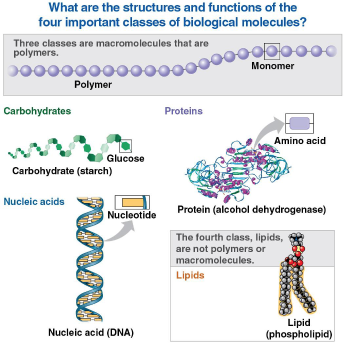
Biological molecules
Macromolecule polymers:
Carbohydrates (like glucose)
Proteins (in amino acids)
Nucleic acids (in DNA)
Non-polymer nor macromolecule:
Lipids
Macromolecules
Large polymers named for their huge size; cells have thousands and different cells have different varieties
Many can be built from just a small set of monomers
Polymer
A long molecule consisting of many similar building blocks called monomers
Includes carbohydrates, proteins, and nucleic acids
Monomer
The repeating units that serve as the building blocks for polymers
Enzymes
Specialized macromolecules that speed up chemical reactions such as those that make or break down polymers
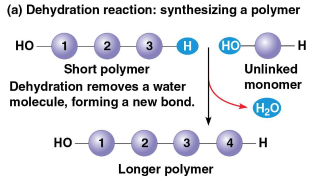
Dehydration reaction
Occurs when two monomers bond together through the loss of a water molecule, thus creating a polymer
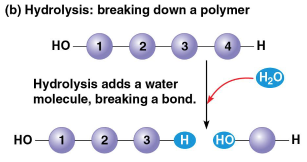
Hydrolysis
The disassembly of a polymer to a monomer, creating a reaction that is essentially the reverse of the dehydration reaction
Carbohydrates
Class of macromolecules that consists of sugars and polymers of sugars
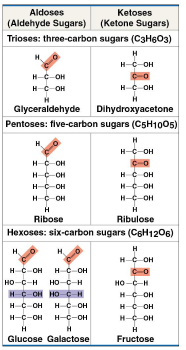
Monosaccharides
The simplest forms of carbohydrates that make up the building blocks of polysaccharides (carbohydrate macromolecules)
Usually have molecular formulas that are multiples of CH2O, such as in glucose (C6H12O6)
Classified by the location of the carbonyl group or the number of carbons in the carbon skeleton
Polysaccharides
Polymers of monomer monosaccharides, creating complex carbohydrate molecules that serve storage and structural roles
Glucose
The most common monosaccharide with the chemical formula C6H12O6
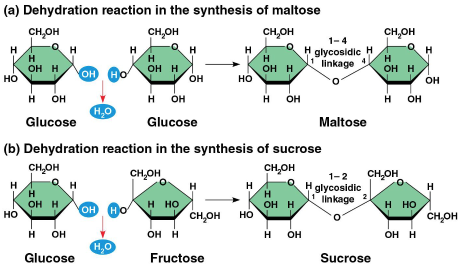
Disaccharides
Formed when a dehydration reaction joins two monosaccharides

Starch
A storage polysaccharide of plants consisting of glucose monomers, such as in potatoes, in granules within chloroplasts and other plastids

Glycogen
A storage polysaccharide in animals, stored mainly in liver and muscle cells for easy utilization and hydrolysis during periods of high demand (like exercise)

Cellulose
A major component of the tough wall of plant cells, it is a polysaccharide
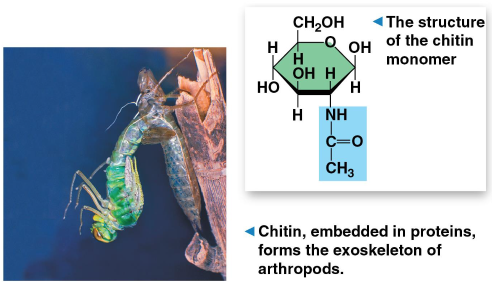
Chitin
Another structural polysaccharide found in the exoskeleton of arthropods as well as the cell walls of many fungi
Lipids
The one class of biological molecules that do not include true polymers, unified by their poor mixture with water
Consist mostly of hydrocarbon regions
Biologically important types include fats, phospholipids, and steroids
Fats
Type of lipid constructed from glycerol and fatty acid molecules
Glycerol
A three-carbon alcohol with a hydroxyl group attached to each carbon
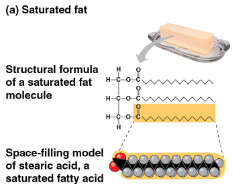
Saturated fats
Fats with the maxiumum number of hydrogen atoms and no double bonds
Solid at room temperature
Includes most animal fats
Can cause cardiovascular disease through plaque deposits
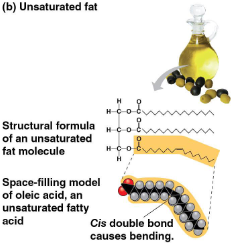
Unsaturated fats
Fats with one or more double bonds and fewer hydrogen atoms
Liquid at room temperature
Includes plant fats and fish fats
Hydrogenation
The process of converting unsaturated fats to saturated fats by adding hydrogen
This leads to trans fats with double bonds in vegetable oils that can contribute to cardiovascular disease
Adipose cells
Cells used for storage in humans and other mammals that cushion the body and organs
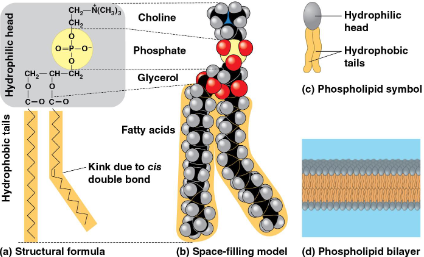
Phospholipid
Type of lipid with two fatty acids and a phosphate group attached to glycerol
Fatty acid tails are hydrophobic, phosphate heads are hydrophilic
In water, they assemble a bilayer with the tails toward the interior as a boundary between cells and their environment
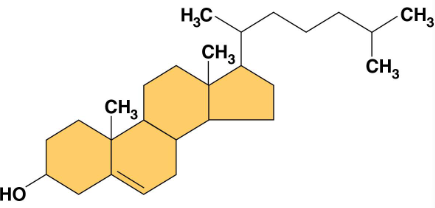
Steroids
Lipids characterized by a carbon skeleton consisting of four fused rings
Cholesterol
A type of steroid from which animal cell membranes and other steroids are synthesized
High levels of this may contribute to cardiovascular disease
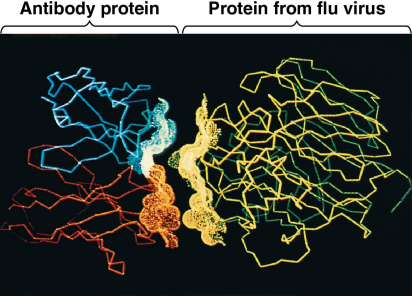
Proteins
Biological molecules that account for more than 50% of the dry mass of most cells, serving in a variety of functions
Contain one or more polypeptides
Functions result from their structure of polypeptides twosted, foiled, and coiled to bind to other molecules

Enzymatic proteins
Proteins that selectively accelerate chemical reactions
Digestive enzymes catalyze the hydrolysis of bonds in food molecules

Defensive proteins
Proteins that protect against disease
Antibodies activate and help destroy virsues and bacteria

Storage proteins
Proteins that store amino acids
Casein in milk is the major source of amino acids for baby mammals
Plants have storage proteins in their seeds
Ovalbumin is the protein of egg white, used as an amino acid source for the developing embryo

Transport proteins
Proteins that transport substances
Hemoglobin is the iron-containing protein of vertebrate blood, transporting oxygen from the lungs to other parts of the body
Transport proteins exist in cell membranes for molecular passage

Hormonal proteins
Proteins that coordinate an organism’s activities
Insulin (a hormone secreted by the pancreas) causes glucose uptake in cells, regulating blood sugar concentration

Receptor proteins
Proteins that aid cellular responses to chemical stimuli
Receptors in nerve cell membranes detect signaling molecules released by other nerve cells

Contractile proteins (motor proteins)
Proteins that function in movement
Motor proteins aid the movement of cilia and flagella
Actin and myosin proteins are responsible for the contraction of muscles

Structural proteins
Proteins that support cellular structures
Keratin is the protein of hair, horns, feathers, and other skin appendages
Insects and spiders use silk fibers to make their cocoons and webs
Collagen and elastin proteins provide a fibrous framework in animal connective tissues
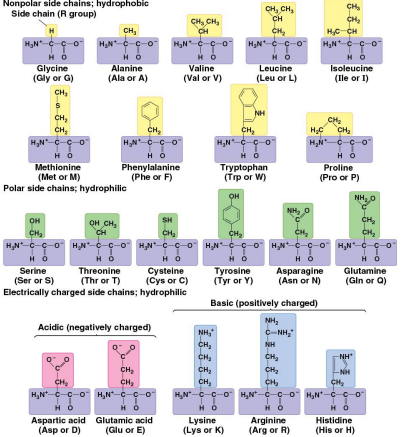
Amino acids
Organic molecules with amino and carboxyl groups that serve as the monomers in proteins
Have differing properties due to differing side chains called R groups
Polypeptides
Unbranched polymers built from amino acids joined by peptide bonds
Peptide bonds
Bonds that join amino acids in polypeptides
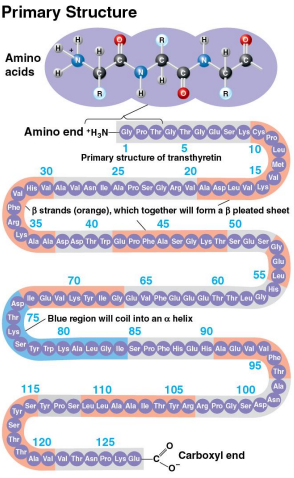
Primary structure
A protein’s first structure defined by its unique sequence of amino acids
Like the order of letters in a long word
Determined by inherited genetic information
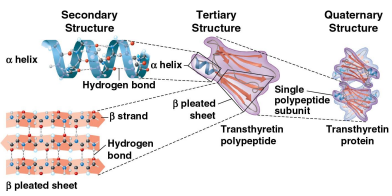
Secondary structure
A protein’s second structure defined by its coils and folds in its polypeptide chains
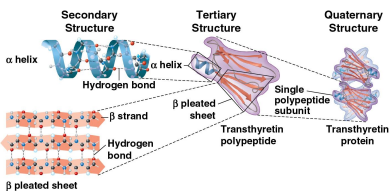
Tertiary structure
A protein’s third structure defined by its interactions among various side chains (R groups)
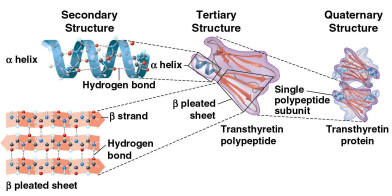
Quaternary structure
A protein’s fourth and final structure when a protein consists of multiple polypeptide chains to form one macromolecule
Collagen consists of three polypeptides like a rope
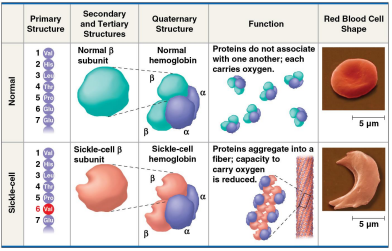
Sickle-cell disease
An inherited blood disorder that results from a single amino acid substitution in the protein hemoglobin, causing an abnormal sickle shape in the red blood cell
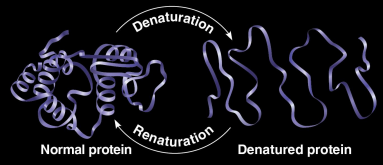
Denaturation
The loss of a protein’s native structure caused by physical or chemical conditions
pH, salt concentration, and temperature are some factors
Extremely high fevers can be fatal because of this
Gene
A unit of inheritance that consists of DNA to program the amino acid sequences of polypeptides
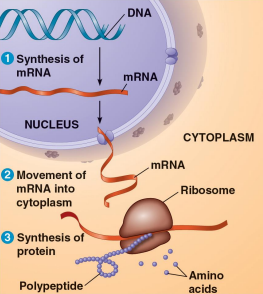
Dioxyribonucleic acid (DNA)
A nucleic acid that comprises genes through monomers called nucleotides and provides directions for its own replication
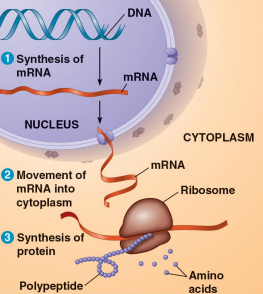
Ribonucleic acid (RNA)
Nucleic acid type that is directed by DNA to control protein synthesis through a process called gene expression
Single-stranded as opposed to double-stranded DNA
Has the thymine (T) base replaced by uracil (U)

Polynucleotides
The term for nucleic acids as polymers of monomers called nucleotides
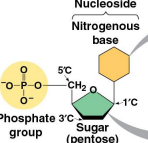
Nucleotides
The monomers of polynucleotides, consisting of a nitrogenous base, a pentose sugar, and one or more phosphate groups
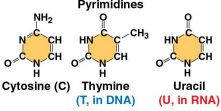
Pyrimidines
One of the two families of nitrogenous bases, comprising cytosine (C), thymine (T), and uracil (U)

Purines
One of the two families of nitrogenous basis comprising adenine (A) and guanine (G)

Deoxyribose
The sugar present in DNA

Ribose
The sugar present in RNA
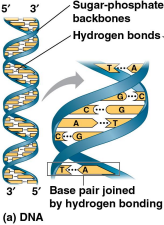
Double helix
The shape of a DNA molecule formed by two polynucleotides in a spiral, running in opposite directions for 5-carbon and 3-carbon sugar strands
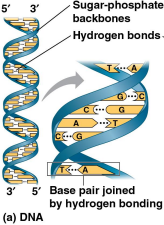
Complementary base pairing
The fact that only certain bases pair with each other in DNA, making it possible to generate two identical copies of each DNA molecule in a cell preparing to divide
Adenine (A) always to thymine (T)
Guanine (G) always to cytosine (C)